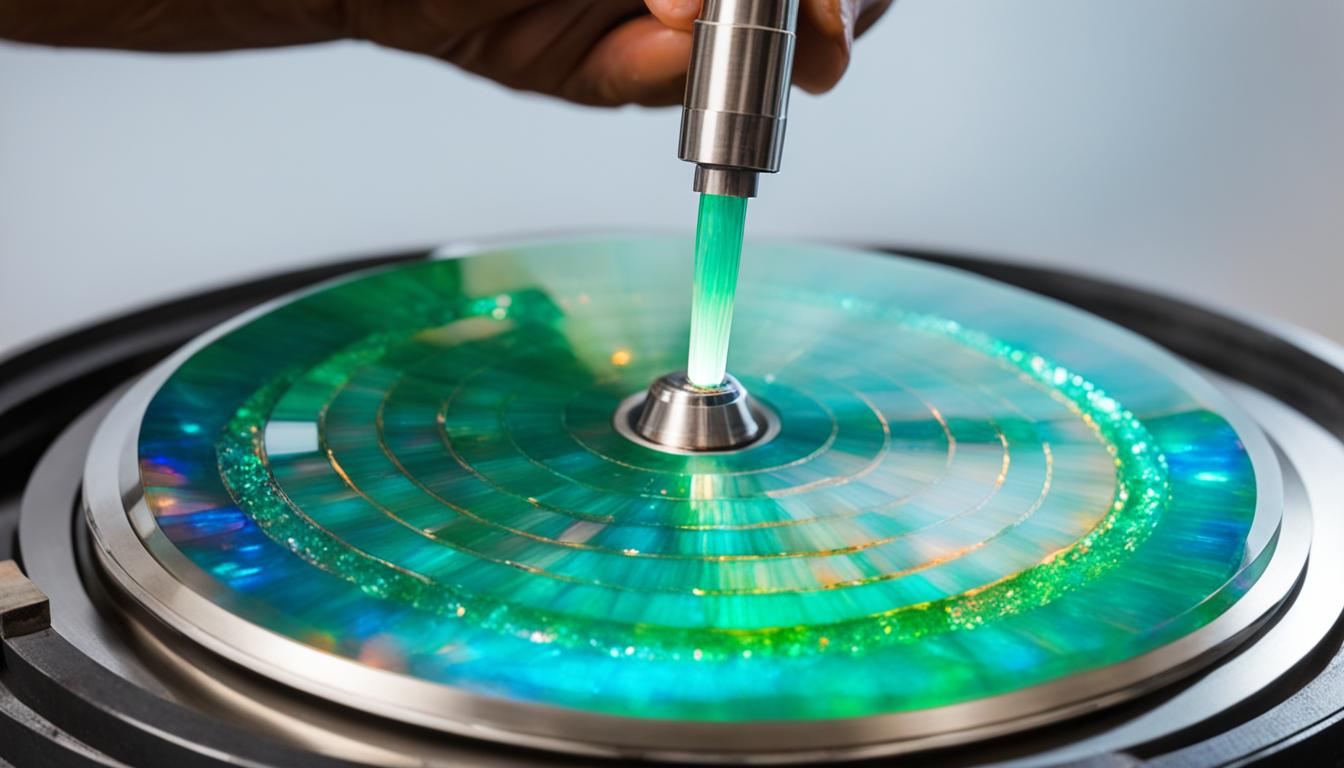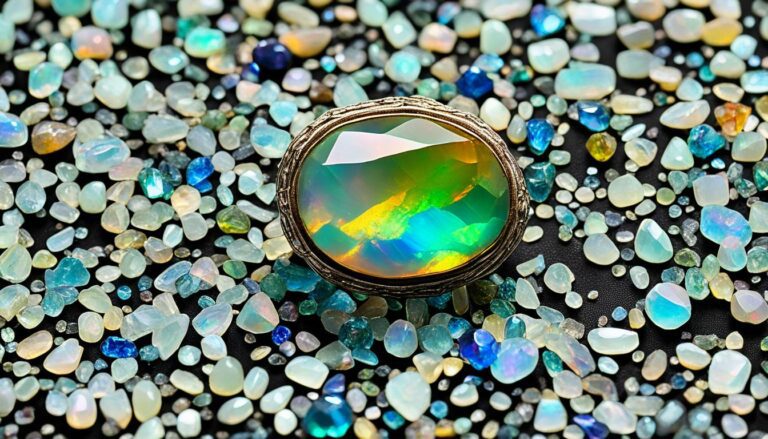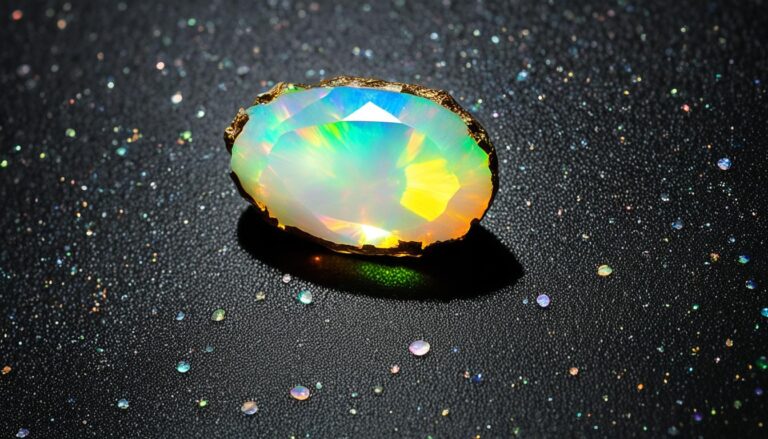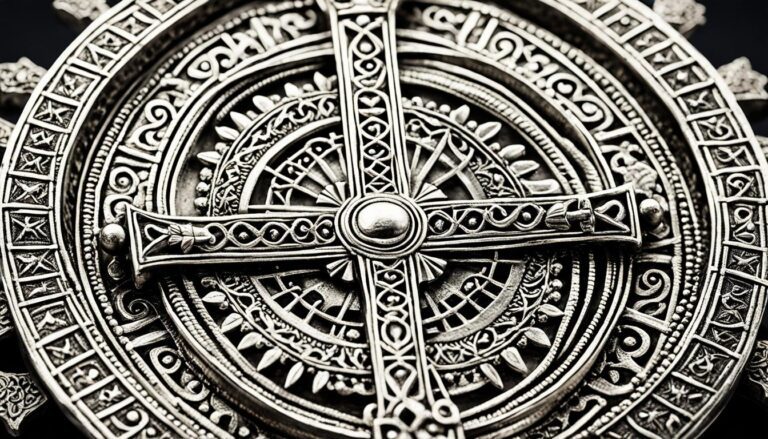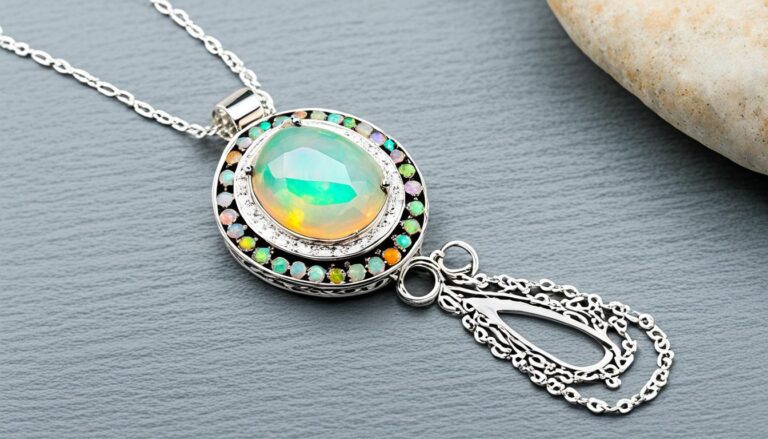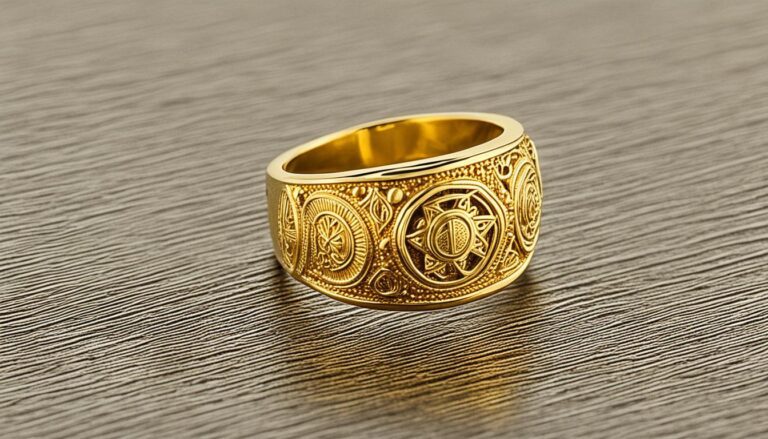How to Polish Ethiopian Opal
Polishing Ethiopian opal takes careful steps. At [Our Brand], we care deeply about your opals. We help both jewelers and fans of gemstones get amazing polish results.
Before you start polishing, check your opal for flaws. This check is key for a smooth polish journey. Fix any found issues first to avoid problems later.
Now, let’s explore how to polish Ethiopian opal. Lapidary machines and Dremel tools work well. Your choice depends on what you’re comfortable with and what you have available.
To shape the opal, you’ll use different grits to bring out its colors and form. For a fine polish, use cerium oxide and a felt wheel. Be sure to cool, wash, and dry the opal properly.
At [Our Brand], we stress the importance of gentle skill and good advice in opal care. If you’re unsure, or have a special opal, professional help is smart.
Polishing Ethiopian opal is more than just making a pretty gem. It’s caring for a piece of nature’s art. Let [Our Brand] lead you on this amazing journey.
Assessing the Opal
Before we start polishing an Ethiopian opal, we check it for cracks or chips. This is important to fix any issues and avoid more problems during polishing.
We examine the opal closely using a gem torch and a jeweler’s loupe. The gem torch shines light directly on the opal, helping us see any small flaws. The loupe, on the other hand, makes the opal larger, letting us inspect it closely.
With the gem torch and loupe, we look for any damage on the opal’s surface. We are searching for cracks or chips. These flaws could harm the opal’s quality or beauty.
By fixing any cracks or chips now, our polishing work will make the opal truly beautiful.
Expert Tip:
It’s a good idea to look at the opal from various angles and lights. This helps us find any hidden flaws. Attention to detail is key to a great finish.
Get ready to polish your opal and reveal its beauty. Next, we will explore how to pick the best polishing method for your Ethiopian opal.
Choosing the Polishing Technique
Polishing Ethiopian opal involves choosing from several methods. A common way involves using lapidary machines with diamond wheels. These machines are precise and efficient, achieving a smooth polish.
Or, you might use a Dremel rotary tool. The Dremel is great for intricate detailing. Many artists appreciate how easily it can be managed.
If you’re looking at your budget and space, flat laps could work for you. They offer a simple yet effective method for opal polishing.
The way you polish opals depends on what you like and what tools you have. Think about the detail and time you’re willing to put in. Also, consider how comfortable you are with different polishing methods.
Trying out various techniques can lead to beautiful opals. Look for the method that lets the opal’s natural beauty shine through.
Shaping the Opal
The journey to make an Ethiopian opal shiny starts by giving it a shape. We use a rough grit – usually around 280. Using a process called rubbing, this step gets the stone ready for its polish.
Rubbing means carefully grinding the opal’s surface. This unveils the bright colors hiding underneath. The stone begins to show off its amazing hues as we shape it.
Making the opal take on a specific shape is very important. It could end up as a smooth oval or in a more unique design. We choose just the right shapes and cuts to highlight its beauty.
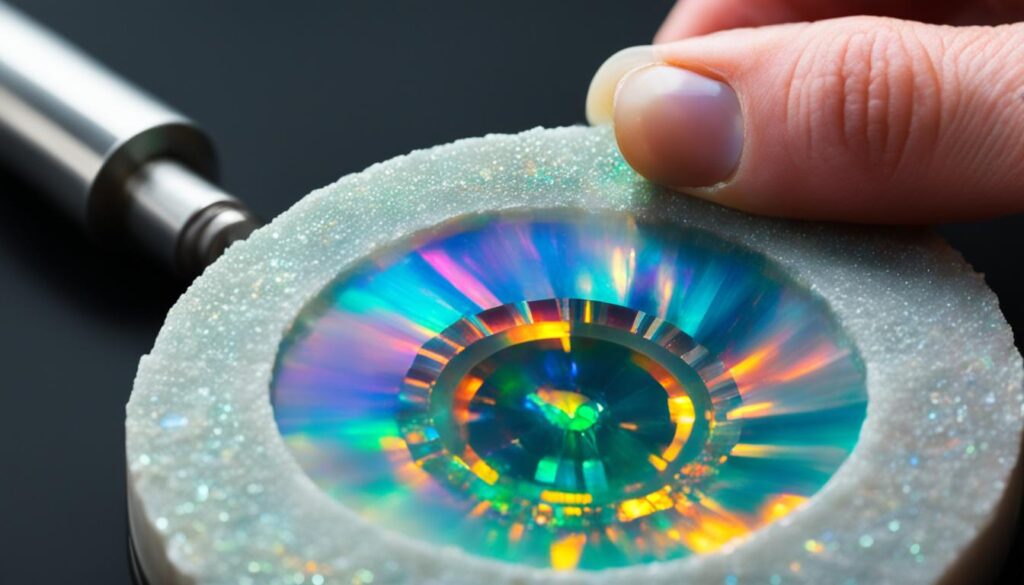
As the grinding progresses, we see the opal take its final shape. By selecting the right grits and through skilled rubbing, we reveal the opal’s colorful glory. It’s how we ensure the opal turns out exactly as we want.
Attaching the Opal for Shaping and Polishing
We’re done shaping the opal, and now we attach it to a doping stick. We use a special wax or super glue. This is a key step for even shaping and polishing the opal. Securely attaching it ensures it stays put for the next steps.
A doping stick gives a stable base for the opal. It lets us apply the needed pressure and control. The wax or glue makes sure the opal won’t move, even as we shape and polish it carefully.
Doping sticks are vital in lapidary work. They keep gemstones in place against shaping and polishing forces. The wax or glue makes a strong hold between the opal and the stick.
Attaching the opal this way makes us confident for the upcoming steps. We can shape and polish the opal well. This shows its best colors, clarity, and shine.
Polishing Steps with Grits and Cerium Oxide
After shaping the opal, we start to polish it. We first use grits, like 280 and 600, to shape and smooth the surface. This step brings out its natural colors and shines.
Next, we use finer grits such as 1200 and 3000 for prepolishing. This makes the surface even smoother. It’s a key step to get that flawless look.
Some may stop at 1200 grit, but others go up to 3000 before the final step.
For the last step, we use cerium oxide polish. This is a paste mixed with water. It’s put on a felt wheel or tool.
The opal is then polished. Its luster shines. The gem looks its best.
Chemically Polishing the Opal for a Brilliant Finish
Chemical polishing with cerium oxide is the last step. This compound makes the opal shiny. It removes any tiny flaws.
During this final polish, gentle pressure is crucial. It needs to be steady. This makes the opal smooth and beautiful.
With both shaping and cerium oxide, we get a stunning opal. Its colors stand out. It’s a testament to our care in making jewelry.
Cooling and Cleaning the Opal
After getting polished, opals must cool before we take them off the dopping sticks. Placing them in the freezer for a short time helps with this. The cold makes the adhesive less tight, so we can remove them gently. This prevents any damage to the opals.
Next, we clean the opals. Start by rinsing them in warm water. This removes any leftover residue from polishing. Use your fingertip or a soft brush to wash them gently. Make sure all sides get cleaned well.
After cleaning, use a soft cloth to dry the opals. Don’t use anything rough or harmful. Just pat them softly to make sure they’re completely dry.
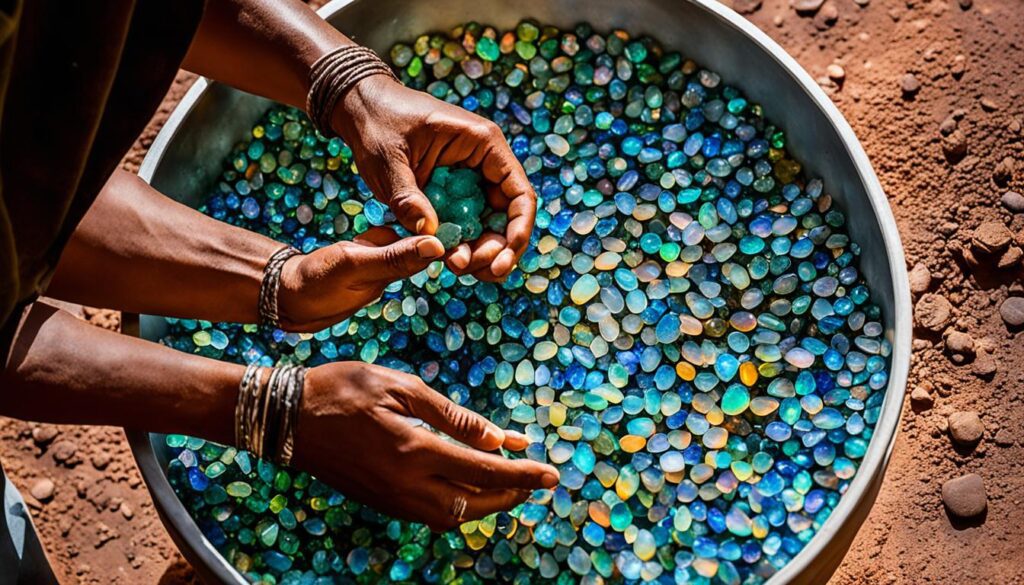
Professional Assistance for Valuable Opals
If you’re pondering over polishing your opals, or if you suspect you own a valuable one, turning to a professional is wise. Opals are fragile and require careful handling. A skilled lapidary or jeweler can guide you, ensuring your opals are polished both effectively and safely.
When dealing with precious opals, professionals have the know-how. They grasp the special needs of opals, offering delicate solutions for polishing. This expertise is crucial to avoid damaging these unique gemstones.
Regardless of an opal’s personal or monetary value, professional help guarantees it’s well-taken care of. These experts are well-versed in opal polishing, using the right tools and equipment. Your opal is safe in their capable hands.
Engaging a professional helps steer clear of errors that might harm your opal. They can evaluate your opal’s quality and suggest the best way to polish it. They consider the opal’s unique traits, vulnerabilities, and the best methods for polishing.
Professional lapidaries and jewelers also provide key opal care tips. They advise on cleaning and maintenance to keep your gem looking its best. Being aware of the correct storage conditions is also crucial for the opal’s longevity.
Choosing professional help for your opals protects your precious investment. This ensures your opal remains vivid and striking. With expert advice, displaying your opal’s beauty and rarity becomes not just a possibility but a confident choice.
Fracture Testing Ethiopian Opal
Before cutting and polishing Ethiopian opal, fracture testing is a must. It checks the opal’s stability and finds hidden cracks. These cracks might hurt the opal’s quality.
There are different ways to do fracture testing. One way is to tap the opal gently with a blunt metal tool. We listen for odd sounds or feel for strange vibrations. These could mean there are cracks inside.
The water test is another method. We put the opal in water and see what happens. If there are cracks, water might show them clearly. This helps us spot areas that need extra care before cutting and polishing.
Testing for fractures in Ethiopian opals helps us ensure they are stable. This reduces the risk of damage when we polish them. Ensuring their quality is key in preserving these special gemstones.
The Importance of Fracture Testing
Fracture testing is key for checking the opal’s condition. It lets us see hidden cracks or flaws. Finding these early helps keep the opal strong and lasting.
Hidden cracks are a big risk during polishing. They can make the gemstone weak, possibly breaking it. Thoroughly testing for fractures means we cut down on problems like recutting or sudden breaks while polishing.
Starting with fracture testing is important to prevent problems later. We aim to provide polished Ethiopian opals that are not just beautiful but also durable. This testing ensures our opals look good and last a long time.
Cutting Ethiopian Opal
After the fracture testing, it’s time to begin cutting the Ethiopian opal. We start by securing the opal on a dop stick with strong glue. This makes sure it stays in place as we cut it into shape.
It’s best to cut the opal with water. Water acts as a lubricant, making the cut smoother. It also keeps the opal cool. This way, we can cut it without harming its beauty.
Cutting focuses on shaping the opal to show its beauty. We choose if we want a cabochon or another shape. Then, we cut away extra material to uncover the opal’s colors and patterns.
Next, the opal must be left to dry completely. It’s best to leave it in a warm, dry spot for this. Patience is key here. Quick drying could harm the opal.
Shaping and Polishing the Opal
Once dry, we shape and polish the opal. We aim for a smooth, shiny surface.
We use finer and finer grits to grind and polish the opal. This process removes rough edges and scratches. It also makes the opal brighter.
Shaping and polishing need careful work. We pay close attention to make the opal shine. This takes time, but the results are worth it.
Shaping and polishing opal is both art and science. With the right skills and tools, we turn rough opal into a beautiful gem. It’s ready for amazing jewelry.
Conclusion
Polishing Ethiopian opal takes careful work. You need to look closely and choose the best way to polish. By using the right tools and methods, the opal will shine beautifully. Make sure to shape it well and use the correct finishes to bring out its unique colors and shape.
Opals are delicate and can break easily. It’s wise to get help from experts, especially if the opal is valuable. They know how to polish opals without harming them. It’s also smart to check the opal for cracks before doing anything else. This step keeps the opal stable.
When done properly, Ethiopian opals are truly stunning. Always handle them with care and seek help when needed. Make use of the correct tools and techniques. With these efforts, your opal jewelry will be exceptional.

